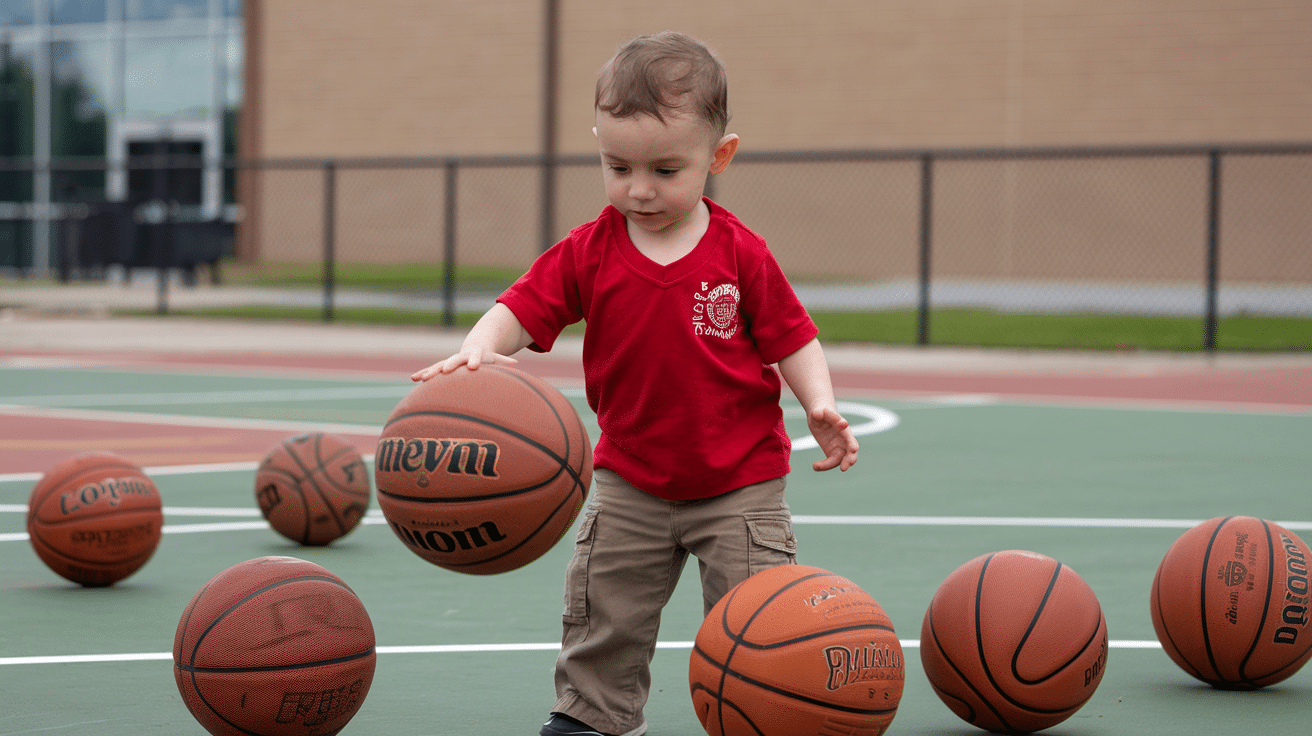Bouncing a basketball might look simple, but for a 5-year-old, it’s pure magic. At this golden age, children soak up new skills like sponges.
Their growing bodies crave movement, and their curious minds want to try everything. Basketball offers the perfect mix of fun and learning.
When kids start basketball at five, they gain more than just ball skills. They build friendships, learn to follow the rules and feel the joy of being part of a team.
The court becomes a classroom where they learn to listen, take turns, and cheer for friends.
This guide offers simple, fun drills for little hands and short attention spans. No fancy skills are needed—just a ball, some space, and your encouragement.
What 5-Year-Olds Need to Learn First?
There is no professional pressure here! Kids need to focus on the fundamentals first—like dribbling, passing, and moving their feet. These skills form the foundation for all future basketball play.
Young children are still working on basic coordination. Keeping things simple leads to more success and enjoyment.
Short attention spans? No problem! These drills are designed to be quick, engaging, and energetic. Most 5-year-olds can focus on a single activity for 5-10 minutes before needing a change.
Breaking practice into short segments keeps their interest high. Kids learn best when they’re having fun and moving constantly.
The goal is simple: Make learning basketball feel like playtime! When kids enjoy what they’re doing, they naturally want to keep practicing.
Using imagination in drills helps capture their attention. Dribbling becomes “keeping a pet ball under control,” or defense turns into “guarding your castle.” These playful approaches make basketball skills click for young minds.
Fun and Engaging Basketball Drills for 5-Year-Olds
1. Dribbling Drills
“Bouncy Castle”: Tell kids their ball is magical and must stay close. Start with 10-second drills at waist height. First, use two hands, then right and left. Count dribbles and cheer for personal bests. Try fun commands: “Dribble high like a giant” or “Low like a mouse.”
“Follow the Leader”: The coach leads a slow parade while kids dribble behind. Keep a walking pace with gentle turns. Add story elements: “We’re in thick mud” (slow dribbles) or “On hot sand” (quick dribbles). Call “Freeze!” sometimes to practice control.
“Zig-Zag Adventure”: Place 3-4 cones in a row, 2-3 feet apart. Kids weave through them while dribbling. Tell a story: “You’re avoiding puddles” or “Going through a forest.” Start with straight lines before trying actual zig-zags.
2. Passing Drills
“Superhero Pass”: Kids stand 3-4 feet apart and chest pass to each other. Teach stepping toward the target. Say, “Use your superpower center!” to explain the proper form.
If working alone, try using hula hoops as targets. Softer balls work well for beginners.
“Catch & Fire”: Pass against a wall or with a helper. Mark a target spot to improve the aim. Count successful passes in a row as a personal challenge. Start with five in a row, then try for ten. Mix in bounce passes as skills grow.
“5-Pass Scramble”: Make teams of 3-4 kids. The first group to make 5 good passes earns a shot. Each player must receive at least one pass. Use a small 10-foot area so passes stay short. Praise good passes as much as baskets.
3. Shooting Drills
“Tennis Ball Toss”: Use tennis balls for easier handling. Start with ground targets (buckets or hoops) before using baskets. Begin just 3 feet away.
Try underhand tosses first to learn proper force. Move back slowly as the aim improves.
“Hot Spots”: Mark 4-5 shooting spots with tape, all within 5-6 feet of a lowered basket. Kids shoot from each place, and track makes on a simple chart.
Focus on bent knees, two-handed form, and using the backboard. Celebrate all attempts.
“Lay-Up Challenge”: Break this skill into tiny steps. First, practice the footwork without a ball. Add paper footprints on the floor as guides.
Start with “step, hold, place” without jumping. Once comfortable, combine steps gradually until they flow together.
4. Defensive Drills
“Guard the Treasure”: One child guards a ball on the ground while another tries to tag it. Teach the stance: feet apart, knees bent, arms wide. Say, “Get low like a frog!” Switch roles every 30 seconds to keep interest high.
“Pirates vs. Sailors”: Sailors dribble while pirates try to tip away balls without touching players. If a sailor loses control, they become a pirate. Use a 15×15 foot space. The last sailor dribbling wins. This teaches defense in a fun, low-pressure game.
“Lightning Shuffle”: Place two cones 5 feet apart. Kids shuffle sideways between them without crossing their feet. Make it fun: “The floor is lava!” Time for 15 seconds to count shuttles.
This builds quick feet for defense. Add a third cone later for triangle patterns.
Pro Tips for Parents and Coaches
Keep sessions short and exciting for young players. Limit drills to 5-10 minutes and include regular water breaks. A full practice should last no more than 45 minutes. Plan to keep kids engaged.
Celebrate small wins with specific praise. Instead of “good job,” try “great eyes up while dribbling!” Create team celebrations that everyone can join in when someone shows improvement.
This builds both confidence and team spirit.
Play upbeat music during drills to make practice fun. Offer simple rewards for effort, not just success. These can be privileges like choosing the next activity.
“Basketball stars” for good sportsmanship keep motivation high and create a positive learning environment.
Common Mistakes to Avoid
Don’t push for perfect technique with young players. Instead, focus on enjoyment and basic skills. Work on just one skill per practice, and remember that all children develop at different rates.
Always include fun elements in your drills. Set up multiple stations so kids stay active rather than waiting in lines. Use colorful equipment and imaginative games to keep them engaged. When you hear laughter, you know they’re learning.
Use appropriate equipment. Junior basketballs and lower hoops allow children to succeed and develop proper form, while full-sized gear forces kids to use incorrect techniques that can become hard-to-break habits later.
Alternate Ideas for Basketball Drills
| Drill Name | Description | Key Benefits |
|---|---|---|
| Obstacle Course Challenge | Set up a mini-course using cones, hula hoops, and chairs for an exciting dribble race. Kids navigate obstacles while controlling their balls, building multiple skills at once. | Enhances dribbling, passing, and shooting skills; builds agility and coordination. |
| Freeze Dribble | This is a musical-chair-style game in which kids dribble while music plays and freeze when it stops. It helps develop focus, control, and listening skills. | Improves ball control, reaction time, and listening skills. |
| Mini Dunk Contest | Use a kid-sized hoop and let kids slam dunk for fun! This activity builds excitement, confidence, and jumping skills while allowing kids to create their dunk styles. | Encourages creativity, confidence, and jumping ability. |
| Red Light, Green Light Dribble | This is a fun twist on a classic game. Players dribble forward on “Green light,” dribble in place on “Yellow light,” and stop on “Red light.” It teaches control and listening skills. | Teaches dribble control, stopping without traveling, and following instructions. |
| Basketball Bowling | Set up plastic bottles or cones as “pins” and have kids roll or bounce basketballs to knock them down. Improves hand-eye coordination and ball control. | Develops hand-eye coordination, accuracy, and ball control. |
Conclusion
When kids start basketball at age five, the real win isn’t about perfect shots. It’s about smiles, high-fives, and the look of joy when they dribble for the first count of three.
These simple drills build more than just sports skills. They teach kids to listen, share, and work with others. The court becomes a place where little ones gain confidence with each bounce of the ball.
Your job? Keep it light. Keep it fun. Praise effort over results.
Will your five-year-old become a basketball star? Maybe. But what matters now is that they learn to love moving, playing, and being part of something special.
So grab that kid-sized ball, lower that hoop, and let the good times roll!












